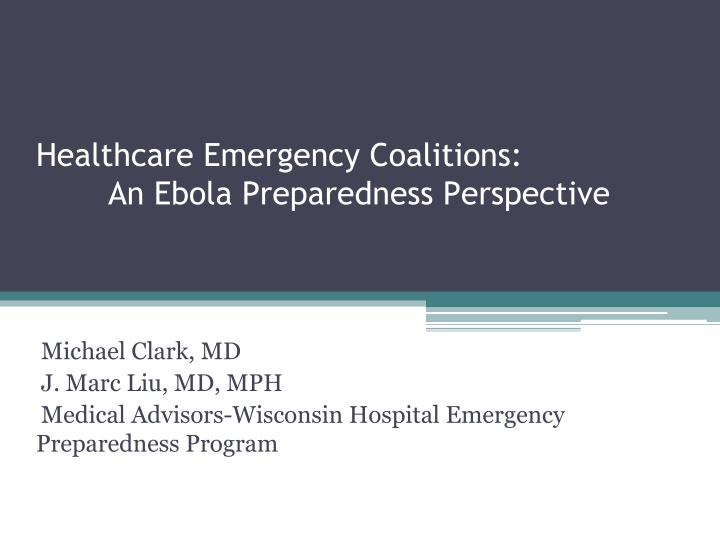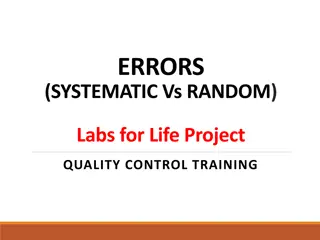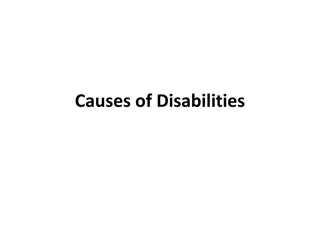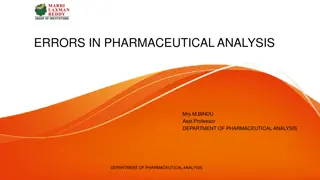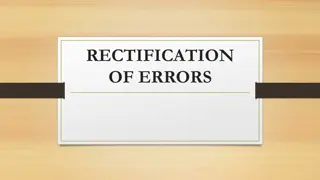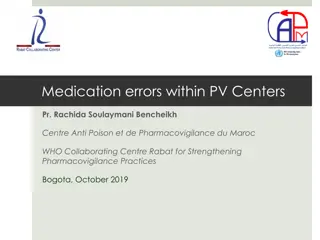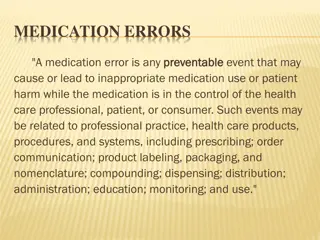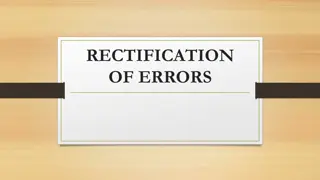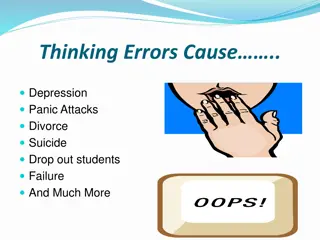Understanding Medical Errors: Causes and Impact
Medical errors are a critical issue often overshadowed in healthcare. This content delves into the root causes, including communication problems, staffing issues, and technical failures. It highlights the alarming statistic that medical errors are the third leading cause of death in the U.S. Research and debates on whether medical errors should be considered criminal offenses add depth to this discussion.
Download Presentation

Please find below an Image/Link to download the presentation.
The content on the website is provided AS IS for your information and personal use only. It may not be sold, licensed, or shared on other websites without obtaining consent from the author.If you encounter any issues during the download, it is possible that the publisher has removed the file from their server.
You are allowed to download the files provided on this website for personal or commercial use, subject to the condition that they are used lawfully. All files are the property of their respective owners.
The content on the website is provided AS IS for your information and personal use only. It may not be sold, licensed, or shared on other websites without obtaining consent from the author.
E N D
Presentation Transcript
Healthcare Emergency Coalitions: An Ebola Preparedness Perspective Michael Clark, MD J. Marc Liu, MD, MPH Medical Advisors-Wisconsin Hospital Emergency Preparedness Program
Healthcare Emergency Coalitions (HCC) Group of healthcare organizations, public safety and public health partners that join forces to ensure community s health and resilience Support communities before, during and after disasters and other health-related crises
HCC Purpose Coordinate how public health, healthcare institutions, and first responder agencies will manage their efforts to enact a uniform and unified response to an emergency, specifically the medical surge aspect of an event (ESF-8) Does not replace day to day functioning of individual disciplines
How could functional healthcare emergency preparedness coalitions help us in this current situation?
DISASTER HEALTHCARE RESPONSE A COALITION MODEL DISASTER HEALTHCARE RESPONSE A COALITION MODEL Community Health Resources Tier 6 National Primary Care Tier 5 DECOMPRESSION SURG Tier 4 State Specialty Care Tier 3 Regional Horizontal Response Capabilities Tier 2 Area Mental Health Hospital and Health Care SystemResources Critical Care Tier 1 Local Acute Care Specialty Care Emergency and Trauma Care Alternate Care Sites Surgical Social Services Rehab Pharmaceutical Diagnostics Disaster Independent Health Care Resources Long Term Care Surgical Pharmaceutical Urgent Care Rehab Alternative Care Primary Care Diagnostics Mortuary Vertical Response Capabilities Emergency Operations Supply Chain Information Sharing Community Recovery Public Health Transportation Fatality Management Volunteers 5
Detection and Screening Situational awareness requires up-to-date, accurate information from numerous sources (= medical intelligence reports) Involvement of many organizations/disciplines Public health Hospitals, clinics, and healthcare facilities EMS and Emergency Responders 911 call/dispatch centers Law enforcement Consistent screening criteria Common forum/communications network for dissemination of information RMCC (the coalition s center) to assist in collecting and relaying data
Patient Referral/Transport Organized plan for safe, effective movement of patient to a healthcare facility for evaluation and care Organizations/disciplines Public health Hospitals, clinics, and healthcare facilities EMS Emergency Management Private Sector Multi-disciplinary, multi-agency coalition would be useful to Designate appropriate agencies and facilities Ensure details of plan between agencies/organizations are linked together
Patient Evaluation and Management Efficient use of resources to manage the patient as well as personnel Cross-disciplinary collaboration Clinical providers and experts Infection control Supply chain Environmental services Public health and epidemiology Media relations Coalition approach would help to Share resources and expertise Manage messaging to stakeholders and public Ensure flow of necessary information Coordinate respective roles/responsibilities
The Aftermath Coalition collaboration to assist in Continued patient and contact monitoring Clean-up and disposal Continued public messaging and education Post-event assessment and improvement Comprehensive analysis of strengths and weaknesses Production of an integrated plan for future events
